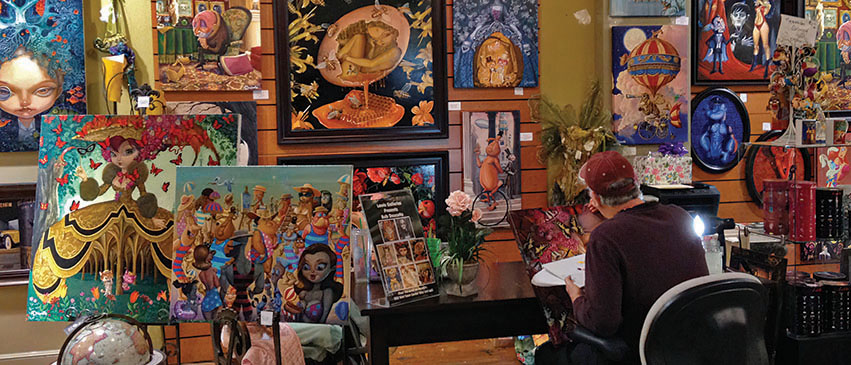
Theater director, puppeteer and doll designer. Painter, animator, filmmaker and storyteller. If this sounds like a dream team for the ultimate entertainment experience, you’d be right. But what if all these skills could be found in a single person? And what if this list doesn’t even begin to scratch the surface of their vast talents?
When Bob Doucette and his husband first moved to Peoria in 2018, there was an undeniable buzz in the arts community. “They moved here from Los Angeles!” people exclaimed, puzzling over the move. “Bob is a famous animator—he even worked on Tiny Toons and Animaniacs!” His reputation had preceded him.
In February 2019, an opening reception featuring Doucette’s work was held at Exhibit A Gallery in Peoria Heights. I was curious to see the artwork, but also to meet the much-lauded artist, and I was clearly not alone. The space was packed… front to back, shoulder to shoulder, full of others hoping to chat with Peoria’s newest celebrity. I remember those few moments we chatted: his kind smile, bright eyes and sincere interest in getting to know his new community. I left with a smile on my face—which, as I have since learned, is exactly what the artist intended.
Making of an Artist
“It’s true!” Doucette says, his eyes growing wide with excitement. We’re chatting over Zoom, the videoconferencing platform that has become essential during this pandemic. He enthusiastically confirms the story I’d heard: that his love for dolls grew out of a childhood desire for one. “The reason I always bring that up is when people look at my paintings, they always go, ‘Well, these look like dolls!’”
Though Doucette was never gifted a doll, he was an enterprising child and soon figured out a way to make his own. Using pipe cleaners and scraps of felt, he would create characters like Dr. Doolittle and Mary Poppins. “I eventually learned how to make puppets,” he adds. “And that’s where it all started.”
Growing up in small-town Maine, Doucette’s artistic abilities were encouraged by his parents. His father, who worked on the railroad, had always hoped to be an artist, but set his aspirations aside in order to care for his family. “He was determined that one of us kids was going to be an artist,” Doucette recalls. When he was just eight years old, he took a painting class. “It was mind-blowing for me. The second I started painting, I was like, This is what I want to do the rest of my life.”
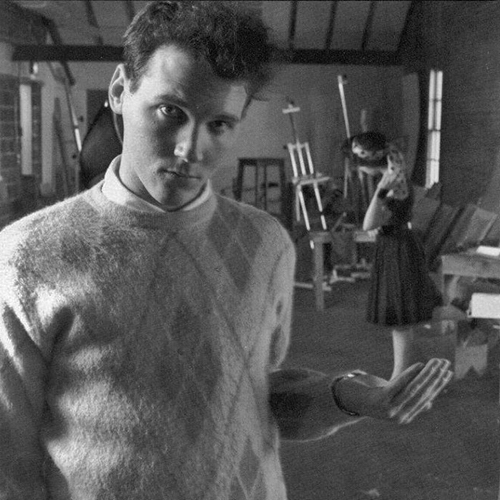
Doucette’s mother was a banker, and advised him to find ways to remain practical. “I think a lot of the decisions I made—like going into animation—were purely out of being practical… to make a good living at what I was doing.”
He pursued a double major in animation and illustration at the Rhode Island School of Design (RISD), and taught at a camp near his parent’s home in Maine during his summer breaks. When the camp’s organizers learned that he attended RISD, they quickly put him to work teaching photography and videography. The camp’s theater director was particularly intrigued by Doucette, who had inquired about working on set designs.
The director instructed Doucette to create a set for a camp talent show in the style of Mad magazine caricature artist Mort Drucker. “I had collected Mad magazine my whole childhood,” Doucette recalls fondly. “He was like, Okay, I’m going swimming—see you later! He left me with a white stage, and when he came back, I had done characters on the whole wall.”
He returned to camp every summer for over a decade, designing sets and costumes, staging plays and making movies. Eventually he became director himself. “[Summer camp] was huge in my life,” he adds. “It’s where I developed my love of all things theatrical.”
Though Doucette was accepted into the California Institute of the Arts (CalArts) for grad school, he instead decided to pursue work as a puppet designer, set designer and performer in Rhode Island. He even met one of his idols, Muppets creator and puppeteer Jim Henson, at a workshop. “He was just as I suspected: kind and generous with his time.”
Soon Doucette was making trips to Los Angeles to work with another director he’d met at summer camp. He was designing sets for operas like Così fan tutte and The Pearl Fishers, and as he spent more and more time there, he started falling in love with the city. It was time for a change—and he finally accepted the offer from CalArts.
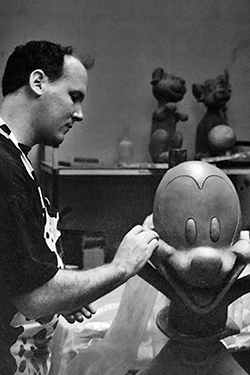
Breaking Into Hollywood
As Doucette pursued his MFA in experimental animation, he was accumulating a wealth of knowledge in storytelling and design, while working in theater on the side. He also met the man he would eventually marry—costume designer Tom Slotten. The two quickly began working together on artistic projects, receiving a string of awards and accolades.
Within a year of graduating, Doucette got his first big break: a job with Warner Bros. as a background painter on Stephen Spielberg’s animated series Tiny Toon Adventures. It was a big step for the artist, though he found his creativity limited. “I didn’t actually draw the backgrounds—the layout person did that,” he explains. “It was weird for me, painting somebody else’s drawing, which I had never done before. You have the tendency to want to fix their drawing!”
It was a laborious task, but it paid off for Doucette, who was able to utilize his skills as a background painter over the years for freelance work. He found other opportunities as well, and soon he was designing caricatures and even writing songs for the show.
After the second season of Tiny Toon Adventures, Doucette was asked to help develop a new animated series. “The producer who worked directly with Steven Spielberg liked me and asked if I wanted to be a director,” he recalls. Concerned that he lacked the experience, Doucette asked if he could instead use the time to learn additional skills. “I did character design, which was really great. And I did that for the rest of my career.”
He jumped into the new production—even designing its logo—and when Animaniacs debuted in 1993, it was a huge hit. By this time, Doucette was a jack-of-all-trades at Warner Bros., taking on everything from storyboarding to character design and layout, to background layout and more. He was also commissioned for a number of custom illustrations.
“When Steven Spielberg won the Academy Award for Schindler’s List, I did this drawing of Babs and Buster Bunny [from Tiny Toon Adventures] giving him an Academy Award,” Doucette recalls with a smile. “Then Steven asked for a picture of [Animaniacs spinoff] Pinky and the Brain posing with Bill Gates,” which Spielberg gifted to the software mogul himself.

About this time, one of the producers at Animaniacs approached Doucette about spearheading another project. “He really wanted to do a superhero show with dogs,” he recalls. “He called them Road Rovers. They had all of these dog-shaped vehicles, and it was all very funny. It was the perfect spoof of the superhero genre.” As creative producer, Doucette oversaw an entire season of 13 episodes.
“Then we sold this very big, expensive show called Histeria!, which was kind of like an Animaniacs for history. I nearly had a nervous breakdown in the middle of it—it was so stressful,” Doucette laughs. “I still enjoyed myself, believe it or not!”
By 1999, however, the demand for animated series had ebbed, and Doucette found himself in a panic—what about his team? He pleaded with the studio to save their jobs. And like any good Hollywood story, they faced a nearly impossible challenge. He and his team were given five days to prepare a pitch for a new show—and they would have to beat rival teams who’d had a six-week head start.
A determined Doucette went home and designed all the characters in a single night. Over the next few days, he and his team fleshed out a show about an oddball group of kids who met in detention, and pitched it to Warner Bros. It was just before the holiday season, so he knew it would be weeks before they found out which team had won. “It was the longest Christmas vacation of my life,” he chuckles. Eventually the news came: Detention was the only pitch Warner Bros. picked up—a testament to Doucette’s unique characters and design sensibility.
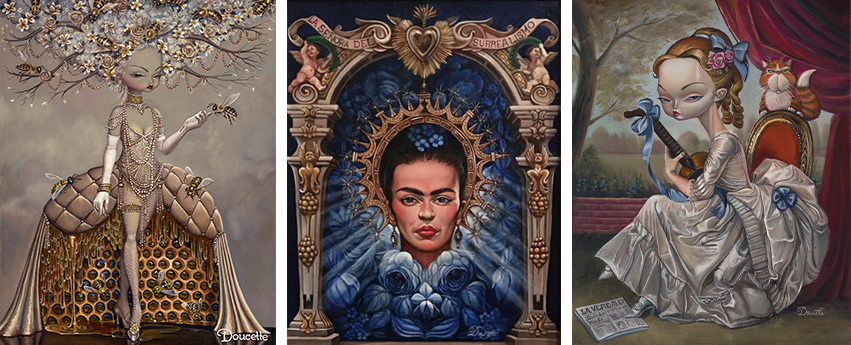
Worlds of Pop Surrealism
Even as Doucette was a rising star at Warner Bros., he maintained dreams of becoming a gallery artist. In 1990, he and Slotten were walking down a street in Pasadena when they happened upon the Mendelssohn Gallery. “They had a show of Mark Ryden paintings and it blew my mind,” Doucette exclaims. “He was doing exactly what I was feeling… this concept of pop surrealism.”
Around the same time, Doucette and Slotten started making custom art dolls together. Most of them were celebrity caricatures, which were very popular at the time. To get the word out, they would advertise their dolls in magazines and interested parties would write to them.
“This was before the internet,” he explains, “so we were doing everything by writing letters.” Their dolls were a hit, attracting high-profile clients like actress Demi Moore, whose purchase provided the down payment on his first house.
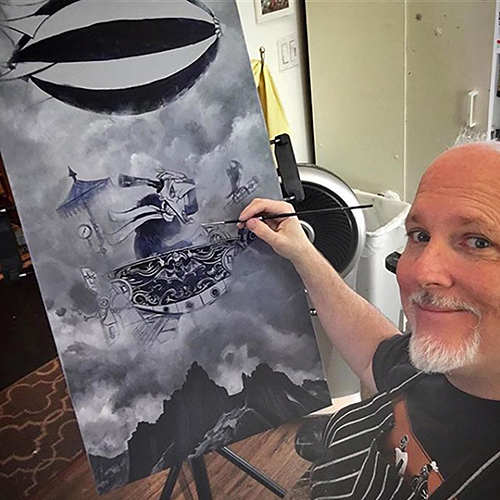
Over the years, however, the frenzy of juggling animation jobs, creating and selling art dolls, and trying to keep up with his painting became too much. He and Slotten were working at an exhausting pace, and Doucette still had yet to become a gallery artist. “Around 2008 I said, this is it,” he recalls. “If I don't start now, I'm never going to make the leap.”
Setting aside his art dolls, Doucette began to focus all of his free time on painting, leveraging the skills and knowledge he had gained from years in the animation business. “We would create a world, and the characters that would go into the world,” he explains. “That’s how I developed my first paintings: world and character building.” He eventually left his animation job altogether to become a full-time painter.
Doucette’s wide-ranging career mirrors the enthralling nature of his work: the closer you look, the more details you find. Many of his pieces feel like collage, with seemingly random images making appearances—a reflection of the times, he muses. “We are bombarded with images from every century and every decade. With the internet and the glut of information out there… I think it’s a response to what the world has become.”
Costuming is key to Doucette’s artwork, and with his husband’s deep knowledge of historical costume design, he has an endless reservoir of ideas. “I find it to be so visceral. I always try to make things eclectic—that’s kind of my goal,” he explains. “I love doing like a 17th-century painting with cellphones… I just find that humorous!”
If you type Doucette’s name into Google’s image search, you’ll see a virtual wall of his paintings. When asked how many he has produced over the years, he laughs. “I’m sure it’s hundreds.” He recently started tracking this metric, and discovered that he completed over 100 paintings in a single year. Given the extraordinary amount of detail he puts into each one, it’s hard to fathom how he works so quickly. For this he credits his time in animation, when he would have to work quickly to mock up different ideas or color schemes.
Doucette’s paintings tend to blend two distinct patterns—those that feel like cartoons, and those that are more surrealist and make use of collage. “If my paintings are ‘cartoony,’ they represent how I see the world. Isn’t life funny? Aren’t people funny with the things they do?” he suggests. “When you see things that are more surrealistic, I’m usually meditating on my own spirituality.”
At the moment, he’s inclined toward the latter. “I am working on a big painting that is circus-inspired because, honest to God, the world could not be more like a circus right now.”
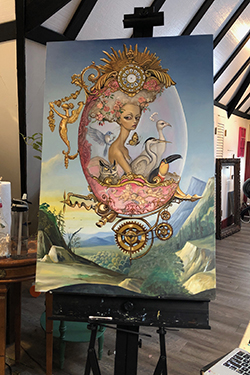
Open Doors in Peoria
After Doucette left his animation career behind, he found the charms of Los Angeles were starting to wear thin. He longed for a smaller community—a respite from the fast-paced city life he’d known for nearly three decades. That’s when a Facebook friend, Steve Spain, owner of The Costume Trunk, suggested that he consider moving to Peoria. After some due diligence online, he and Slotten came for a visit—and eventually moved into a beautiful, historic home on Moss Avenue.
It might seem like an unusual move to some, but Doucette’s approach to life is one of looking for open doors. “It’s a funny thing,” he remarks. “A need arises, and if your eyes are open… I think the universe directs you.
“I bought a lot of peace of mind,” he observes. “Peoria has made me feel like a part of the community instantly.” It’s a relationship that goes both ways.
With the onset of the COVID-19 pandemic, Doucette has noticed an uptick in his social media following. “I think people are looking to be fulfilled,” he reflects. “As a culture, we do not always appreciate that the arts are behind so many things that we enjoy—and how much they elevate us and help us feel better.”
I recall again my initial introduction to Bob Doucette, how I’d left Exhibit A Gallery smiling. Little did I know the decades of work that went into producing that experience—theater, puppets, dolls, painting, storytelling and animation. I was… fulfilled.
“That is why I like the idea of, you know, bingeing,” he continues. “Sometimes you just want to go to the candy store and binge on all the sweet things! Everything—art, TV shows and movies. I think it shows the value of what we do as artists and entertainers.”
I remember growing up—how much I enjoyed the irreverent antics of Animaniacs characters Yakko, Wakko and Dot as a kid. Now here I was, interviewing the man who had brought so much joy to me and countless others.
“It makes me feel good that I can make people happy in times that are stressful,” he finishes. It’s what Bob Doucette has been doing his entire life—only now he’s doing it in Peoria, Illinois. PM
Learn more about the art of Bob Doucette at bobdoucette.com.
- Log in to post comments

